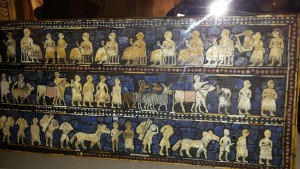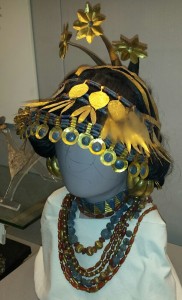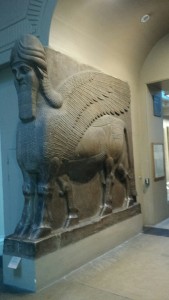Visit Mesopotamia by way of Great Russell Street and the British Museum. I did exactly that a few weeks ago when I availed myself of one of the Museum’s Eye Opener  Tours. These take place in a range of the Museum’s galleries daily. Each lasts between 30 and 40 minutes, though, if there are lots of questions, they may last longer. The Museum also has lunchtime gallery talks and Friday evening spotlight talks. Guides are curators, subject experts or volunteers with a personal and long-standing interest in their subject e.g. my guide was an Iraqi lady, who was able not only to talk at first hand about the various sites where artefacts had been discovered, but also taught us how to pronounce their names. All this is fascinating and it is ALL FREE.
Tours. These take place in a range of the Museum’s galleries daily. Each lasts between 30 and 40 minutes, though, if there are lots of questions, they may last longer. The Museum also has lunchtime gallery talks and Friday evening spotlight talks. Guides are curators, subject experts or volunteers with a personal and long-standing interest in their subject e.g. my guide was an Iraqi lady, who was able not only to talk at first hand about the various sites where artefacts had been discovered, but also taught us how to pronounce their names. All this is fascinating and it is ALL FREE.
My magical history tour began back when our ancient ancestors in the Fertile Crescent, that area between the Tigris and Euphrates rivers ( modern-day Iraq ), began to practice organised agriculture. The creation of settlements, the better to share labour, followed and by the third millennium BCE there were towns and cities. The first urban population was in existence. We know quite a bit about them – their worship, their agriculture, their legal disputes ( I begin to think that there were lawyers, even before there were ‘publicans, tax-gatherers and sinners’ ) their customs and the way they spent what leisure time they had ( they were beer drinkers and board game players, among other things ).
The Museum has artefacts going back to the third millennium BCE, from the cities of Ur and Uruk and some of them are spectacular. The panel showing the lion-headed, eagle-bodied god Imdugud ( above left ) at the Temple of Ninhursag ( southern Iraq ) from c. 2500 BCE and the famous ‘Standard of Ur’ a large box or casket upon which are scenes depicting war on one side and peace on the other ( right, photograph of the peaceful side, c. 2600 ) . There is also what is believed to be the oldest board game in the world, the Royal Game of Ur ( see left below ) dating from between 2600 and 2400 BCE. It comes with  its own set of rules, just like a modern board game, so can still be played. You can see the counters which belong to each player and the beautifully carved squares of the board. There are replicas of the game for sale in the Museum shop.
its own set of rules, just like a modern board game, so can still be played. You can see the counters which belong to each player and the beautifully carved squares of the board. There are replicas of the game for sale in the Museum shop.
I will not try to recount here all that I learned, as we journeyed from Ur to Nineveh and Babylon, to the elaborate palaces of Belshazzar and Nebuchadnezzar. Biblical territory. And Classics territory. I learned that ‘Medes’, as in ‘the Medes and the Persians’ from Xenophon, is pronounced ‘Med-ez’ not ‘Meeds’. As a child I was taught to say ‘meeds’ and have done so ever since – wrongly, as it turns out.
The artefacts  range from the small and exquisite, like the headdress below, a reconstruction of necklaces and headgear found in the tomb of Sumerian Queen Puabi ( c. 2600 BCE ) to the monumental, like the tile-work lion from the Palace of Nebuchadnezzar II. He was the Biblical King in the Book of Daniel who conquered Jerusalem and threw recalcitrant subjects into the fiery furnace. He is also credited with building the Hanging Gardens of Babylon, certainly built the famous Ishtar Gate ( because it is so inscribed ) and went mad for seven years ( something modern historians attribute to everything from clinical lycanthropy to syphilis ). He
range from the small and exquisite, like the headdress below, a reconstruction of necklaces and headgear found in the tomb of Sumerian Queen Puabi ( c. 2600 BCE ) to the monumental, like the tile-work lion from the Palace of Nebuchadnezzar II. He was the Biblical King in the Book of Daniel who conquered Jerusalem and threw recalcitrant subjects into the fiery furnace. He is also credited with building the Hanging Gardens of Babylon, certainly built the famous Ishtar Gate ( because it is so inscribed ) and went mad for seven years ( something modern historians attribute to everything from clinical lycanthropy to syphilis ). He  is portrayed in the famous image by William Blake, as the mad king in the wilderness. One cannot help but find stories everywhere.
is portrayed in the famous image by William Blake, as the mad king in the wilderness. One cannot help but find stories everywhere.
Our tour began in Rooms 55 and 56 and ended on the ground floor, with the huge winged human-headed bulls ( c.710 ). These are images of lamassu, protective deities often carved at the entrances to houses or palaces. They were also adopted, during WWII, as the insignia of the British 10th Army, a field army which served in Persia and Iraq. This part of the world has often been fought over ( see the Standard of Ur,  earlier ), just as it is, horribly, today.
earlier ), just as it is, horribly, today.
The British Museum web-site lists all the exhibitions, tours and lectures available – free and otherwise – on a daily basis. I’m already planning my next visit to see the exhibition of drawings of Rome, but I’ll take in a tour as well and maybe a lecture. There will be lots of other stories. You may even read about them at The Story Bazaar.
If you enjoyed reading this article you might also like The First Library ‘X’ marks the spot In the beginning.. A Walk on the Wild Side Easter Doings


 RSS – Posts
RSS – Posts
2 responses to “The Land of the Two Rivers”